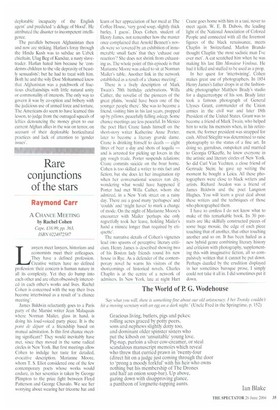Rare conjunctions of the stars
Raymond Carr
A CHANCE MEETING by Rachel Cohen Cape. .£16.99, pp. 363, ISBN 0224072587 Lawyers meet lawyers, historians and economists meet their colleagues. They have a defined profession. Creative writers have no defined profession: their concern is human nature in all its complexity. Yet they do bump into each other and are often obsessively interested in each other's works and lives. Rachel Cohen is concerned with the way their lives become intertwined as a result of 'a chance meeting'.
James Baldwin reluctantly goes to a Paris party of the Marxist writer Jean Malaquais where Norman Mailer, glass in hand, is doing his loud-voiced party piece. It is the point de depart of a friendship based on mutual admiration. Is this first chance meeting significant? They would inevitably have met, since they moved in the same radical circles in New York, But first meetings allow Cohen to indulge her taste tor detailed, evocative description. Marianne Moore, whom T. S. Eliot considered one of the few contemporary poets whose works would endure, in her seventies is taken by George Plimpton to the prize fight between Floyd Patterson and George Chuvalo, We see her worrying about wearing her tricorne hat and
learn of her appreciation of her meal at The Coffee House, 'very good soup, slightly thick barley. I guess'. Does Cohen, student of Henry James. not remember how the master once complained that Arnold Bennett's novels were so 'covered by an exhibition of innumerable small facts' that they 'exhaust our reaction"? She does not shrink from exhausting us. The whole point of this episode is that Marianne Moore was asked to sit at Norman Mailer's table, Another link in the network established as a result of a 'chance meeting'.
There is a lively description of Mark Twain's 70th birthday celebrations. Willa Cather, the novelist of the pioneers of the great plains, 'would have been one of the younger people there'. She was to become a friend. visiting him in his last years, propped up by pillows, peacefully falling asleep. Some chance meetings are less peaceful. In Mexico the poet Hart Crane lands himself on the short-story writer Katherine Anne Porter, later to become a literary grande dame. Crane is drinking himself to death — eight litres of beer a day and shots of tequila — and is arrested for picking up lovers in the gay rough trade. Porter suspends relations; Crane commits suicide on the boat home. Cohen is too skilled a writer to mix fact and fiction, hut she does let her imagination rip when her conversational sources run dry, wondering what would have happened if Porter had met Willa Cather, whom she admired, in a New York street on a rainy day. There are a good many perhapses' and 'coulds' and 'might haves' to mark a change of mode. On the night of Marianne Moore's encounter with Mailer 'perhaps she only regretfully took her leave, holding Mailer's hand a minute longer than required by etiquette'.
The narrative details of Cohen's vignettes lead into spasms of perceptive literary criticism. Henry James is described showing two of his Boston lady friends round his new house in Rye. As a defender of the contemporary novel he warns his visitors of the shortcomings of historical novels. Charles Chaplin is at the centre of a network of admirers. In New York, late at night Hart Crane goes home with him in a taxi, never to meet again. W. F. B. Dubois, the leading light of the National Association of Colored People and connected with all the foremost figures of the black renaissance, meets Chaplin in Switzerland. Marlon Brando thought Chaplin 'the most sadistic man I've ever met'. A cat scratched him when he was making his last film Monsieur Verdoux. He had it killed and stuffed to be used as a prop.
In her quest for 'intertwining', Cohen makes great use of photographers. In 1854 Henry James's father drops in at the fashionable photographer Matthew Brady's studio for a daguerreotype of his son. Brady later took a famous photograph of General Ulysses Grant, commander of the Union armies in the civil war and later 18th President of the United States. Grant was to become a friend of Mark Twain, who helped him to write his memoirs when, in his retirement, the former president was strapped for cash. Alfred Stieglitz was determined to raise photography to the status of a fine art. In doing so, garrulous, outspoken and married to Georgia O'Keeffe, he knew everyone in the artistic and literary circles of New York. So did Carl Van Vechten, a close friend of Gertrude Stein; he gave up writing the moment he bought a Leica. All these photographers were close to black writers and artists. Richard Avedon was a friend of James Baldwin and the poet Langston Hughes. You will learn a great deal about these writers and the techniques of those who photographed them.
I have to confess I do not know what to make of this remarkable book. Its 30 portraits are like skilfully constructed pieces of some huge mosaic, the edge of each piece I touching that of another, that other touching another and so on. It has been hailed as a new hybrid genre combining literary history and criticism with photography, supplementing this with imaginative fiction, all so compulsively written that it cannot be put down. Perhaps dazzled by the erudition displayed in her sometimes baroque prose, I simply could not take it all in. I did sometimes put it down.


































































 Previous page
Previous page